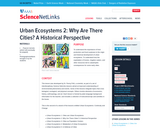
In this unit, students will learn about the five themes of Geography Mapping: location, place, human environment interaction, movement, and region.
- Subject:
- Social Studies
- Material Type:
- Unit of Study
- Provider:
- LiveBinders
- Date Added:
- 07/24/2018

In this unit, students will learn about the five themes of Geography Mapping: location, place, human environment interaction, movement, and region.

Students examine infrared Landsat images that show the city of Kathmandu in different years in order to analyze the urban development of Kathmandu and seasonal changes.

Students examine a Medium Resolution Imaging Spectrometer (MERIS) image that contrasts the lush vegetation of the Nile delta and the dry sand of the Sahara.

In this interactive matching game, students consider 10 fascinating artifacts from Europe and North America and match them to the roles they played for Stone Age humans. There is also a printable version.

This lesson focuses on the importance of geographic features and the abundance of natural resources that helped ancient Egypt become the world's first superpower. Students will learn about the geography and resources available to the ancient Egyptians and create a multimedia tour that demonstrates this learning to others.

How have agricultural challenges in the past been solved through the use of technology? What kinds of challenges do farmers face today? What tools do they use to help them fix the problems? Support your STEM and Social Studies curriculum with this video that profiles a California pistachio farmer who developed an iPad app to improve irrigation. Then, use the accompanying lesson plan to have students research historical and contemporary agricultural innovations.

In this lesson, students explore the importance of food production and food surpluses to the origin and historical development of urban ecosystems. To understand how the exploitation of forests, irrigation waters, and other resources led to catastrophic consequences for some early cities.

This inquiry provides students with an opportunity to investigate the role of agriculture in the growth of complex societies. Students will examine sources related to the development of agriculture, the emergence of ancient writing in Mesopotamia, and the rise of social inequalities as they construct an argument in response to the compelling question "Was the development of agriculture good for humans?"

Students use satellite imagery to learn about rice-growing in Vietnam.

This inquiry provides students with an opportunity to evaluate a series of innovations by three complex civilizations - Maya, Aztec, and Inca. Students explore how complex societies and civilizations adapt to and modify their environment to meet the needs of their people.

This is an encyclopedia entry for the term "ecosystem." An ecosystem is a geographic area where plants, animals, and other organisms, as well as weather and landscape, work together to form a bubble of life. Text for this entry is appropriate for the middle and high school grade levels.